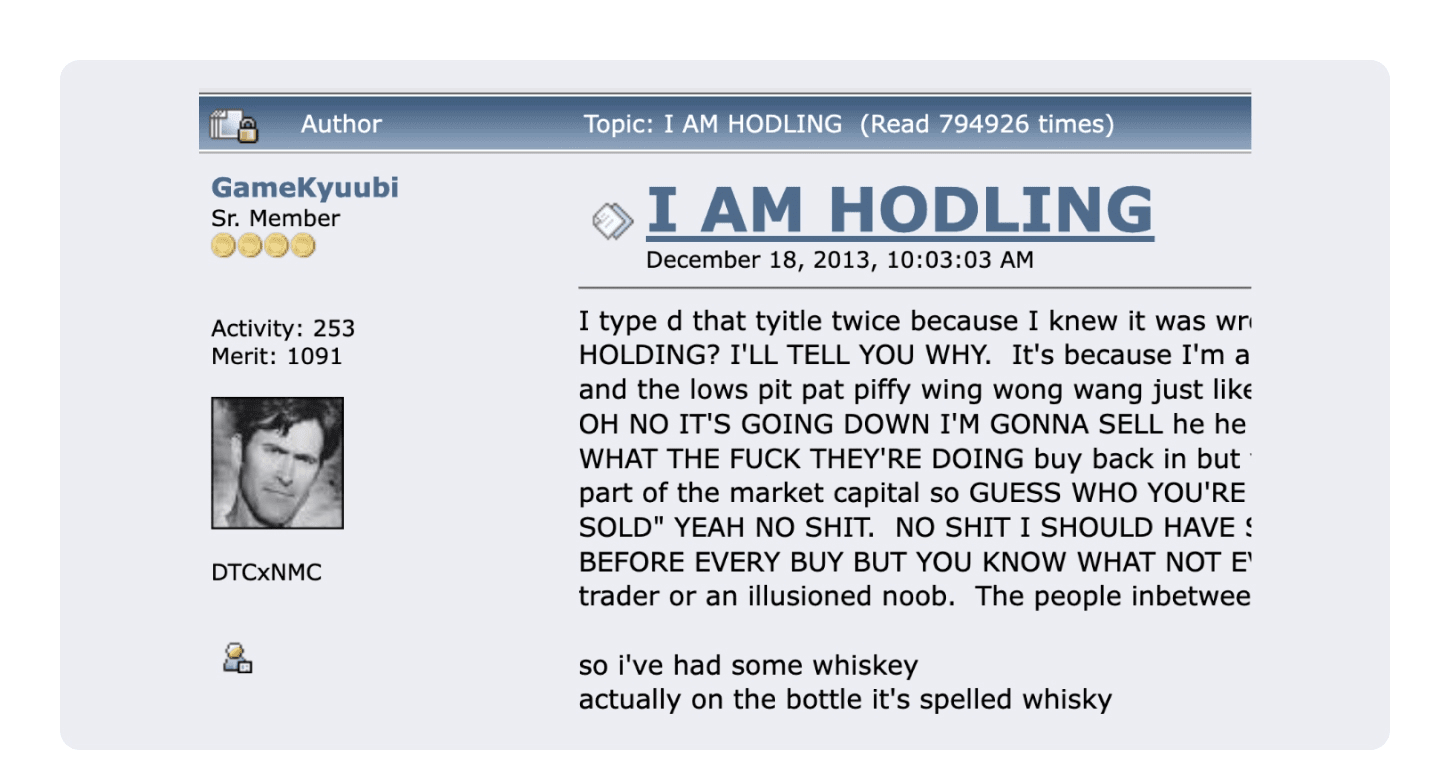1
What is holding cryptocurrency?
Holding cryptocurrency means holding it long-term rather than selling it, regardless of market volatility.
In 2013, a post appeared on the Bitcointalk forum late at night titled 'I HODL'.
A user, clearly frustrated by market fluctuations and perhaps having had a couple of drinks, meant to say 'held'.
However, the typo remained. In the following years, the word 'HODL' transformed from a meme into a mindset.
In a space thriving on hype, FOMO trading, and 100x bets, holding offered a radically simple idea: buy Bitcoin and don't touch it. No day trading activity. No panic selling. Just conviction.
Now, in 2025, the world looks quite different, but holding is here to stay. This strategy underpins many of the largest success stories $BTC , especially considering that more long-term investors are entering the market.
Central banks are still battling inflation, institutions are accumulating reserves, and Bitcoin has transformed into a macro asset. In such conditions, waiting has paid off.
So, what is holding in cryptocurrency today? It is a long-term strategy regarding Bitcoin that is still relevant, works, and is perhaps more justified than ever.

Did you know? The original 'HODL' post was written in response to a 39% drop in Bitcoin price in one day (December 18, 2013). User GameKyuubi admitted to drinking whiskey and 'trading poorly', but still decided to hold. This candid honesty helped the post go viral.
2
Ideas underlying Bitcoin preservation in 2025
Holding can be viewed as a psychological defense mechanism against one of the most volatile markets in history.
The principle of loss aversion—well known in behavioral finance—underlies this thinking.
According to research by Nobel laureate Daniel Kahneman, people feel the pain of loss about twice as strongly as the pleasure from an equivalent gain.
In cryptocurrency, where 20% fluctuations in a day are not unusual, this emotional bias can lead to irrational decisions: panic selling at the bottom or buying due to FOMO at the top.
Hodlers reject this impulse. They share what the crypto community calls 'diamond hands'—commitment to long-term confidence even when the market declines. It's not about timing peaks and troughs; it's about standing firm when others falter.
This approach is closely tied to the fact that in 2025 Bitcoin is increasingly positioned as a store of value. Fidelity, BlackRock, and other major organizations now mention Bitcoin alongside gold in their asset allocation reports.
According to CoinShares, more than 70% of the circulating Bitcoin supply has not changed in over a year—this is the highest level on record. This is intentional cryptocurrency ownership by long-term investors, including exchange-traded funds (ETFs), pension funds, and sovereign wealth funds.
In short, holding is stoicism combined with finance.
Did you know? By 2025, over 94% of the total Bitcoin supply will have already been mined. Thus, less than 1.05 million BTC remains to be created—ever—and it is expected that this process will reach some sort of mathematical completion by 2140.
3
Market context for 2025: is it worth holding Bitcoin?
If you have held Bitcoin over the past few years, you've had to endure a lot: the fallout from the FTX collapse, a brutal bear market, global inflation spikes, and constant talk of regulation. And yet, in 2025, Bitcoin is still standing—perhaps stronger than ever.
As of August 18, 2025 #bitcoin is at $114,878

Of course, it won't all be smooth. Regulation is tightening. While Bitcoin has largely avoided the worst, broader crackdowns on cryptocurrency mean it will never be completely out of the line of fire. Some countries are already discussing implementing capital controls on cryptocurrencies to manage capital outflows, especially during times of currency stress.
Additionally, there is a rise of central bank digital currencies (CBDCs) spreading everywhere from the EU to Asia. They are positioned as 'safe digital money', and while they do not compete directly with Bitcoin, they shape governments' approach to monetary control on the blockchain. With the introduction of tokenized US Treasury bonds yielding over 5% on the blockchain, the landscape of digital value is expanding; Bitcoin is no longer the only alternative.
Energy is also back in the spotlight. Environmental, social, and governance (ESG) issues have not gone away, despite the fact that, according to the Bitcoin Mining Council, more than half of Bitcoin mining is now powered by renewable energy. Nevertheless, political rhetoric does not always consider the data.
So... is it still worth holding?
Many think so. The stock-to-flow model, while not perfect, still sets long-term price targets in the six-figure range. ARK Invest modeled a potential Bitcoin price of over $1 million by 2030 in its bullish forecast, while Fidelity predicts strong long-term growth based on network adoption.
4
Bitcoin in the long term: tools and platforms in 2025
In 2025, keeping assets afloat does not mean burying your stash somewhere in the backyard and praying for the best. Today, there is a whole suite of tools designed specifically for long-term holders.
Cold vs hot: how holders store their Bitcoins
At the most basic level, holders still choose between hot wallets (connected to the internet) and cold wallets (offline storage).
Cold wallets, such as Ledger, Trezor, or isolated devices like Ellipal Titan, remain the best solution for long-term storage. They are harder to hack, easier to control, and perfect for those who do not plan to touch their coins for years.
For those who prefer accessibility, hot wallets such as Sparrow, BlueWallet, or even browser wallets on Nostr clients have significantly improved their security levels.
Many of them are now integrating with multi-signature settings or connecting to decentralized identification systems for recovery, making them more user-friendly than just a few years ago.
Institutional-level storage and yield options
An increasing number of non-interventions from asset holders—especially wealthy individuals and institutions—are turning to qualified custodians.
Platforms like Fidelity Digital Assets, Coinbase Custody, and BitGo offer secure asset storage solutions with built-in compliance features. These services often offer additional benefits, such as portfolio insurance, automatic rebalancing, or integration with trust and estate planning.
But it's no longer just about storage. By 2025, more BTC owners will start utilizing their resources:
Lido, best known for staking and staking #Ethereum has expanded its operations to include derivatives for Bitcoin staking, allowing users to earn returns on wrapped BTC positions without losing control over them.
Platforms like Liquid and Babylon are experimenting with staking models built into Bitcoin, allowing BTC to secure sidechains or earn rewards similar to validator rewards without needing to re-stake.
Tokenized treasury bill storage and BTC-backed stablecoins now enable users to earn income while maintaining a presence in Bitcoin. (This can be compared to a DeFi version of a long-term savings account.)
Automation tools
Today, holding can also be automated. Services like Swan Bitcoin and River Financial allow users to set up recurring purchases—essentially dollar-cost averaging—and automated withdrawals to cold storage. At the same time, platforms like Casa and Unchained Capital offer multi-signature setups with built-in inheritance planning and recovery processes.
There are also tools like Zaprite or Timechain Calendar that help holders track portfolio growth without directly connecting to wallets—ideal for those who want to see the situation without disclosure.
#BitcoinBasics #holding #Binance